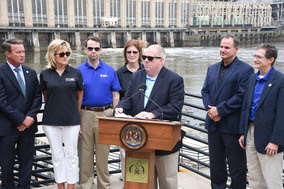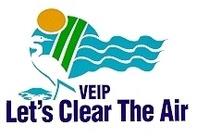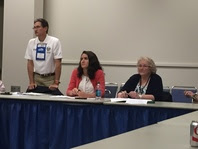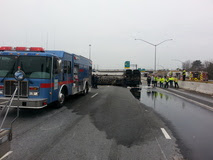eMDE – Summer Success
THE LATEST FROM THE MARYLAND DEPARTMENT OF THE ENVIRONMENT

Summer Success
As we approach Labor Day, the time is right to share some news and views about a very productive summer for us at the Maryland Department of the Environment and around the state. This includes environmental progress on Chesapeake Bay restoration, climate change, clean air and materials reuse and sustainability.
Clean Water and the Chesapeake Bay
In June, Governor Hogan was elected by the members of the Chesapeake Bay Program — six states, the District of Columbia, the U.S. Environmental Protection Agency and the Chesapeake Bay Commission — to chair its Executive Council, which will be important in steering the discussion on Bay restoration strategies. In August, Governor Hogan convened his second Conowingo Dam Summit along the Susquehanna River. This is a big step in preventing nutrient and sediment pollution to achieve our aggressive Chesapeake Bay cleanup goals. The state’s efforts will lead to first-ever dredging of some of the 200 million tons of sediment built up behind the Dam and beneficial reuse of the dredged material, along with important pollution prevention projects upstream to reduce erosion and runoff.
 And, speaking of the Conowingo Dam, we accepted public comments on the Proposed Relicensing of the Conowingo Hydroelectric Project Application for Water Quality Certification under the Clean Water Act in advance of a public hearing we expect to hold in the coming months. Maryland will use all available tools, including a potential veto under the federal Clean Water Act, to protect the Susquehanna River and Chesapeake Bay in the relicensing of the Conowingo Dam.
And, speaking of the Conowingo Dam, we accepted public comments on the Proposed Relicensing of the Conowingo Hydroelectric Project Application for Water Quality Certification under the Clean Water Act in advance of a public hearing we expect to hold in the coming months. Maryland will use all available tools, including a potential veto under the federal Clean Water Act, to protect the Susquehanna River and Chesapeake Bay in the relicensing of the Conowingo Dam.
On the same day as the summit, Governor Hogan and I welcomed governors’ water policy staff and environment secretaries from 28 states for a two-day conference on integrated and innovative water planning, management and financing. Governor Hogan and Governor Jerry Brown (D-California) co-chair this important new effort to share best practices on “One Water” strategies and collaborations with agriculture, natural resources, energy and commerce.
Also in August, Governor Hogan joined Baltimore City and County leaders in a ribbon-cutting ceremony for one of the area’s most important investments in water infrastructure and watershed protection: Baltimore’s Back River sewage treatment plant headworks project to help prevent sewage backups into buildings, streets and neighborhoods. MDE has been a consistent supporter, providing financial assistance for the $400 million project and regulatory oversight to ensure progress is being made for the Inner Harbor and the Chesapeake Bay Region. The U.S. Environmental Protection Agency also approved Maryland’s $303 million plan to implement clean water projects across the state.
We all know the importance of clean water and a healthy Bay to our quality of life and Maryland’s economy. That point was underscored at the start of the summer swimming season with the release of our annual Healthy Beaches Progress Report, which found that Maryland beaches were open for swimming with no health-based advisories nearly 99 percent of the time in the summer of 2016. We’re still collecting information on this summer, but we expect to see similar results.
Climate Change
On August 23, Maryland made major news on the climate change front. Governor Hogan and representatives from eight other states in the Regional Greenhouse Gas Initiative (RGGI) announced a consensus agreement on a proposed plan to strengthen and renew the “cap and trade” program through 2030. MDE’s Air and Radiation Administration and Maryland’s Public Service Commission helped to lead the effort to improve the environmental and economic ground rules and continue to show the world how states can partner to combat climate change through innovative and market-based programs. We also agreed to host the regional/national stakeholder meeting Sept. 25 in Baltimore.
Clean Air
While we continue to make progress in reducing air pollution generated in Maryland, pollution that blows into Maryland from upwind states continues to be a major problem. In June, Maryland was eIected by its colleagues to chair the Ozone Transport Commission, a 13-state, regional collaboration created under the federal Clean Air Act to control interstate smog. In July, Maryland notified the EPA that it intends to sue federal regulators for their failure to act on a 2016 petition requiring power plants in five upwind states to reduce pollution that significantly affects the quality of the air that Marylanders breathe. EPA’s approval of the petition is critical to protecting the health of Marylanders and is important to a healthy Maryland economy. Maryland will use all available tools and strategies, including suing EPA, to get clean air progress upwind and throughout the Chesapeake Bay region
 Also in July, Governor Hogan announced regulatory reforms that will save Maryland taxpayers time and money, as well as protect the health of our environment, through common sense changes to the state’s Vehicle Emissions Inspection Program (VEIP). These targeted improvements for vehicle emissions testing increase customer convenience, while maintaining our progress on air quality and the Chesapeake Bay.
Also in July, Governor Hogan announced regulatory reforms that will save Maryland taxpayers time and money, as well as protect the health of our environment, through common sense changes to the state’s Vehicle Emissions Inspection Program (VEIP). These targeted improvements for vehicle emissions testing increase customer convenience, while maintaining our progress on air quality and the Chesapeake Bay.
 Materials Reuse and Sustainability
Materials Reuse and Sustainability
In August, MDE hosted a very successful meeting at the Maryland Association of Counties summer conference with counties, businesses, agencies and other stakeholders on the governor’s new executive order on waste reduction, resource recovery and sustainable materials management. Several businesses and waste management organizations attended to learn more about rethinking product design, packaging, reuse, recycling and resource recovery strategies. The new executive order is focused on getting to zero waste through achievable and collaborative partnerships, including the beneficial reuse of materials, from discarded glass to dredged sediment.
Moving Forward at MDE
Also this summer, we realigned and renamed some organizations within MDE. In the spirit of integrated “One Water” management, we are combining the Water Management and Science Services administrations into a new Water and Science Administration. This partnership will foster better customer service by providing a single administration responsible for water planning, permitting, water quality and water quantity. I believe this partnership will improve the Department’s ability to handle its most important water decisions and bring necessary resources to our highest water priorities for enhanced environmental results.
 We also made revisions to some MDE office names to reflect current responsibilities more accurately. The Air and Radiation Management Administration is now the Air and Radiation Administration. The Land Management Administration is now the Land and Materials Administration, reflecting the range of materials and substances covered, as well as Governor Hogan’s executive order on Sustainable Materials Management. The Office of Emergency Preparedness and Planning is now the Office of Emergency Preparedness and Response, reflecting the broader responsibilities of the team beyond planning. I am confident these positive changes will help MDE succeed in its mission of protecting and restoring the environment for the health and well-being of all Marylanders.
We also made revisions to some MDE office names to reflect current responsibilities more accurately. The Air and Radiation Management Administration is now the Air and Radiation Administration. The Land Management Administration is now the Land and Materials Administration, reflecting the range of materials and substances covered, as well as Governor Hogan’s executive order on Sustainable Materials Management. The Office of Emergency Preparedness and Planning is now the Office of Emergency Preparedness and Response, reflecting the broader responsibilities of the team beyond planning. I am confident these positive changes will help MDE succeed in its mission of protecting and restoring the environment for the health and well-being of all Marylanders.
A Final Thought
While our mission is focused on Marylanders, our hearts and minds can’t help but focus on broader needs and experiences beyond our borders. Family, friends and colleagues in Texas and Louisiana are enduring catastrophic losses. Thoughts and prayers go out to all impacted by Hurricane Harvey’s immediate devastation and the inevitable suffering and environmental contamination in the weeks and months ahead. I am sure our Emergency Preparedness and Response team can learn from as well as share insights and resources with those involved in the response and long-term recovery effort. May the remaining days of summer and the rest of the year be as productive as the last few months, and may we always remember those less fortunate than us.
In the News
Baltimore Sun
Hogan VEIP regs: Clean air, less hassle
The Hogan administration isn’t backsliding on the notion that regulation of auto emissions is of vital importance for the environment and public health, it is merely recognizing that testing new cars after two years isn’t accomplishing anything. Governor Hogan’s move saves motorists a small amount of money and hassle, but more importantly, it conveys the message that the VEIP isn’t some arbitrary exercise in officiousness.
WBAL-TV
Piles of sediment behind Conowingo Dam reach capacity
Mounting scientific reports reveal piles of pollution trapped behind the Conowingo Dam have reached capacity. “We have a continual leakage of nutrients and sediments, which can undermine our important efforts to protect the Chesapeake Bay,” Secretary Grumbles said.
Read more
WJZ-TV
Maryland plans lawsuit against EPA under Clean Air Act
Republican Gov. Larry Hogan’s administration announced plans to sue the Environmental Protection Agency if the agency doesn’t respond to Maryland’s request to make sure power plants in neighboring states use pollution controls
Read more
Baltimore Sun
In Maryland, rescuing food that might otherwise be wasted
On one end of this particular food chain are boxes of dinged-up tomatoes, spotty avocados and other perfectly edible yet rejected fruits and vegetables that pile up at the Maryland Wholesale Produce Market in Jessup. On the other end are the estimated one in four residents of Baltimore who live in food deserts, where lack of money or transportation limits their access to fresh, healthy fare beyond what little might be carried in their corner stores.
Matt Burke, at the wheel of a Kia with the back seat folded down, is helping to connect the chain.
Air, Land, Water – Did you Know?
MDE at the Maryland State Fair
State fair goers, be sure to stop by the MDE booth in the Miller Mosner building. There’s a Rethink Recycling craft station for the kids, and more.
Watching our Waste
A recent study commissioned by MDE’s Land and Materials Administration found that nearly 70 percent of the waste Marylanders create could be diverted by composting, recycling or by donation. The 2016 Maryland Statewide Waste Characterization Study captured disposed waste at eight landfills and one transfer station across Maryland, including in Cecil, Carroll, Somerset, Charles, Calvert, Garrett and Washington counties and Baltimore City.
2017 Maryland Green Registry Awards
Five Maryland organizations received leadership awards during the eighth annual Maryland Green Registry awards celebration, held in partnership with the Registry, Annapolis Green and the U.S. Green Building Council Maryland.
The awards were presented by Maryland Department of the Environment Secretary Ben Grumbles to BD Diagnostics in Sparks, Hamilton Associates in Owings Mills, the Town of Emmitsburg in Frederick County, Harford County Public Schools, and Washington Gas. Winners were chosen based on their commitment to continuous environmental improvement within their facilities and the environmental results achieved to date. More information on each winner’s achievements are detailed on the Maryland Green Registry website.
Have an Idea?
Email the Editor
 We’re always looking for ways to make eMDE even better. Here’s a chance to tell us what you think. Have some thoughts on what we can do better or things you’d like to see more of? An idea for a specific story? We want to hear from you. Contact us at editor.mde@maryland.gov.
We’re always looking for ways to make eMDE even better. Here’s a chance to tell us what you think. Have some thoughts on what we can do better or things you’d like to see more of? An idea for a specific story? We want to hear from you. Contact us at editor.mde@maryland.gov.
MDE’s Mission
Our mission is to protect and restore the quality of Maryland’s air, water, and land resources, while fostering smart growth, a thriving and sustainable economy and healthy communities.


